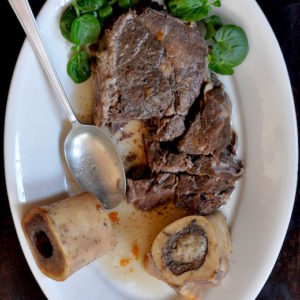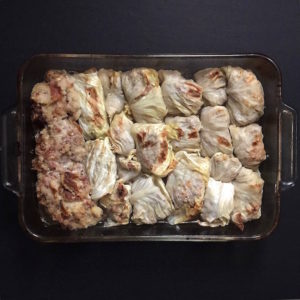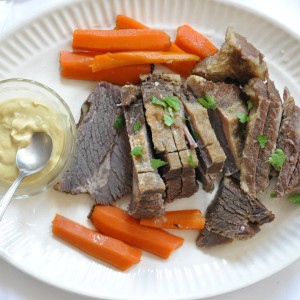Pot Au Feu revisited
Pot-au-feu is one of the big classics. As such, it never goes out of style. I’ve yet to hear of attempts to veganize it, keto it, or substitute cauliflower for the meats and call it “clean” (this is not a suggestion. Food is not dirty unless you drop it on a dirty floor.).

That is, when done well. Badly done pot-au-feu is miserable. Meat–either over or undercooked–swims in a lake of greasy, tasteless liquid. Vegetables are lumpen mush.
 I am very short on pot-au-feu pictures. I’m sorry. Meanwhile, I give you currants.
I am very short on pot-au-feu pictures. I’m sorry. Meanwhile, I give you currants.
Hence my decision to revisit the recipe. Prior pot-au-feu failures were the result of my slavishly following recipes warning against cooking the dish on all but the lowest of low heats.

These radishes did not go into the pot. See excuse above.

Over very low heat, my pots-au-feu did not cook. They did nothing at all. All day faded into night and dinner loomed, I grew increasingly frustrated (okay, frantic). Eventually I would give up, turn the oven on, and transfer the pot from stovetop to oven, effectively transforming au feu to au four. The results, as you might imagine, weren’t exactly Southwest France in The Bay Area.

Now, cooking vessels: ideally you have your great-great grandmother’s marmite, and your great-great grandmother was Lulu Peyraud. Madame Peyraud, may her soul rest in peace, had a large family. You are probably not a relative. Nor am I. Maybe you possess a tall, narrow pot of some heavy material–enamelled cast iron, for example–that you somehow inherited or received as a gift. No? Me either. I use a five-quart, wide-mouthed Staub pot. It is enamel over cast iron, weighs twelve tons and at $500, may be the most expensive object I own. It is not ideal, but few things in life are.

Moving on to broth. Pot-au-feu makers say the difficulty in preparing great pots-au-feu lies in simultaneously producing flavorful meats, sprightly vegetables, and a tasty broth. To that end, some cooks discard the initial batch of vegetables, considering them spent. Just before serving time, they prepare a fresh batch of vegetables, often in salted water.
I feel life is hard enough without this kind of fuss, but feel free.

The tasty broth issue is easily resolved by preparing the pot-au-feu using part broth, part water. This broth can be beef, chicken, or a mixture of broths with water. If you cannot or will not make your own, now is the time to purchase that expensive bone broth promising to cure all ills. It won’t, but it will improve your pot-au-feu.

Avoid dull-tasting meats by using bony cuts like short rib and/or oxtail. Marrow bones and pig’s trotters also boost taste, if you can find them and consume pork products.

Pot-au-feu is traditionally served in two courses: the broth first, the meats and vegetables second. Having no dishwasher and raging repetitive stress injury, I serve everything at once, in large bowls.
Leftover broth may be frozen for soup. Or, to quote Al Yankovic, just eat it.

Pot-Au-Feu
adapted from Judy Rodgers’s recipe in The Zuni Cafe Cookbook
Serves: this recipe serves 2 with leftovers, but is easily scaled upward to feed the masses.
Preparation time: ideally the meats are salted 24 hours in advance. Actual cooking time is 2-4 hours, depending on meats, your stove, and the cooking vessel; this cooking time is largely unattended.
Please read through recipe before cooking, including notes at bottom. Pot-au-feu is not difficult to prepare, and requires no special equipment, but does take a little time and care.
As discussed in the post, the ideal cooking vessel is tall and narrow. Enamel over stainless steel or other heavy material is ideal, but use what you have; I used a Staub 5-quart/5 liter enamel over stainless steel pot. If short and squat is all you have, so be it.
Ingredients:
3 bone-in short ribs, cut to fit your pan if necessary. Your butcher will do this. I know books say this, and people often laugh, but the butchers at my market readily cut through short ribs.
6 cups/1.5 L chicken or beef broth
2 cups/500 ml water
salt and pepper
bay leaves (I used 2)
a thyme sprig (optional)
root vegetables of your choice; I used one turnip, 2 carrots, 1 rutabaga (swede), 1 shallot lobe, and 3 garlic cloves. All vegetables were peeled, trimmed, and sliced.
To accompany the pot-au-feu at the table:
a dish of flaky sea salt
French cornichons
Good bread
Mustard vinaigrette (see notes)
Optional:
Three days to twenty-four hours before cooking, pre-salt the short ribs, using one tablespoon salt per 1pound/454 grams meat. Cover meat with foil or plastic wrap and refrigerate.
On the day you plan to cook, fill a large pot with lightly salted water. Bring to gentle simmer and add ribs. Simmer for two minutes, then rinse the meat in cold water and place in your chosen pot-au-feu vessel.
Add the broth/water. Turn the heat to medium low and bring the liquid to a simmer. Skim, skim, skim.
Add salt, pepper, bay leaves, and thyme sprig. Taste to see if more salt is needed; probably yes.
Cook at a decent simmer for about an hour, skimming all the white. I skim using a Chinese skimmer bought at 99Ranch Market. I wipe the fat off the skimmer with a paper towel soaked in white vinegar, then clean the skimmer well in hot soapy water, to avoid clogging my very moody sink drain.
After an hour, add the vegetables. Cooking time should take another 1-2 hours, depending on the meats, your pot, and your stove. The pot-au-feu is done when the meats are yielding but not mushy. The dish will need a lot of salt: keep tasting. It will hold over low heat for an hour or so, but take care not to overcook.
Serve with cornichons, sea salt, mustard vinaigrette, bread, and a green salad, if wished.
Pot-au-feu will keep, well covered, refrigerated, up to three days (the broth is the most perishable part.) The broth will freeze well, as will any leftover meats; the vegetables will become mushy.
Notes
About the meats:
You can use one type of meat or a variety. Whatever you decide, remember this is a long-cooked dish, so thin, boneless cuts, like those meant for stir-frying, aren’t what you want here. Bone-in cuts of meat or poultry are best, like short ribs, oxtails, bone-in chicken parts, or lamb shanks. Marrow bones are great if you can get them, as are pork trotters.
Boneless cuts that work well in pot-au-feu are thick, dense pieces of meat like brisket and tongue. Brisket is expensive, and some people find tongue repulsive. Only you know what you and your tablemates will enjoy.
About the vegetables:
Use a selection of root vegetables you like: celery root, carrots, onions, leeks, turnips, rutabagas. Some people include wedges of cabbage, others do not. If you want to include cabbage, simmer it separately, towards the end of cooking. Add to dishes at serving time, as cabbage can become sulfurous with long cooking, impacting the entire dish. I say this as a cabbage lover.
I added garlic to my pot-au-feu. I haven’t seen it in other recipes, but I love garlic.
About the broth:
I used six cups of home-canned chicken broth and two cups of water. You may need to add a bit more water during cooking time. You can use all water, or all broth; while homemade broth is best, high-quality, low salt broth from the market is fine.
Skimming is chore and a bore and a hassle. Do it during the first hour of cooking. You will be rewarded with a better-tasting broth.
Taste for salt throughout the cooking time; the dish will need a great deal.
About the seasonings:
Fresh thyme freezes well. I buy it in plastic bags and keep it in my freezer. Some people are adept at growing it on their windowsills. I am not one of those people.
Some pot-au-feu recipes call for cloves. I am not fond; if you are, feel free to add a few.
About the mustard vinaigrette:
Judy Rodgers gives a recipe for mustard vinaigrette in The Zuni Cafe Cookbook, but I ended up making something far off her recipe:
About two tablespoons seedy mustard
about tablespoon olive oil
about one scant tablespoon broth from the pot-au-feu, chilled
sea salt to taste
about teaspoon each red wine vinegar, Modena aged balsamic vinegar, and white wine vinegar
Basically, I kept mixing the above ingredients until I arrived at a level sharpness I liked.
Since writing the above I have added Amora mustard to my cooking repetoire. It is expensive, but I feel it is well worth the cost. I add it here as a suggestion.





